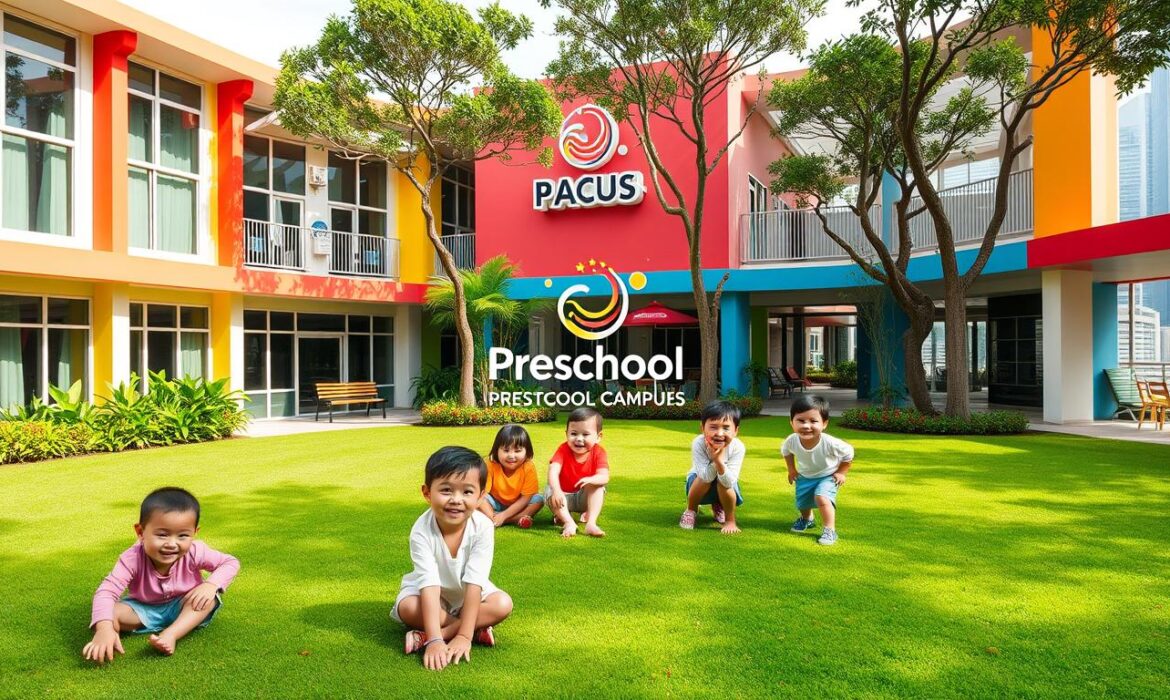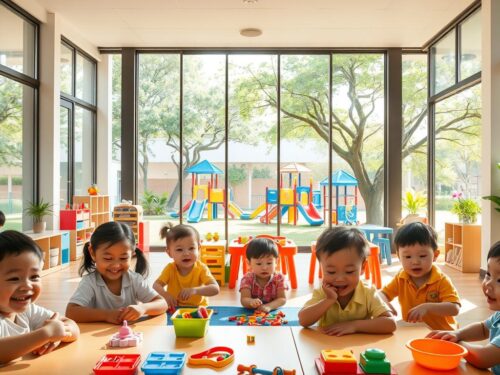Singapore is known for its world-class education system, and this excellence extends to early childhood learning. Parents seeking the right environment for their children’s growth have a variety of options to consider. This guide highlights some of the most reputable institutions that focus on nurturing young minds.
These schools are selected based on comprehensive criteria, including curriculum quality, facilities, and awards. They emphasize holistic development, ensuring children are equipped with future-ready skills. Parent testimonials and first-hand research further validate their effectiveness.
Choosing the right place for early education is a crucial decision. This article aims to simplify that process by providing detailed insights into what makes these institutions stand out.
Key Takeaways
- Singapore offers high-quality early childhood education options.
- Featured schools focus on holistic development and future-ready skills.
- Evaluation criteria include curriculum, facilities, and awards.
- Parent testimonials and research support the selection process.
- This guide helps simplify the decision-making process for parents.
Introduction to the Best Preschools in Singapore
Exploring early childhood education options in Singapore can be an exciting yet overwhelming journey for parents. The city-state is home to a competitive landscape of institutions, each offering unique programs to support young learners’ growth.
Starting your research early is crucial. Ideally, parents should begin exploring options 6 to 12 months before enrollment. This allows ample time to visit campuses, understand curricula, and make informed decisions.
One of the key differentiators between institutions is their focus on bilingual programs versus specialized curricula. Some schools emphasize language proficiency, while others prioritize STEM or arts-based learning. Understanding these differences helps parents align their child’s needs with the right program.
Another important factor is SPARK certification. This accreditation ensures that schools meet high standards in areas like teaching quality, safety, and curriculum design. It’s a reliable indicator of a school’s commitment to excellence in early childhood education.
Here’s an insider tip: even within well-known chains, branch quality can vary. Visiting multiple locations of the same institution can provide a clearer picture of what to expect.
- Start your research 6-12 months before enrollment.
- Compare bilingual programs and specialized curricula.
- Look for SPARK-certified institutions.
- Visit multiple branches of the same chain to assess quality.
By considering these factors, parents can navigate the vibrant landscape of preschools in Singapore with confidence and clarity.
Why Choosing the Right Preschool Matters
The early years of a child’s life are critical for shaping their future. During this period, brain development milestones occur rapidly, laying the foundation for cognitive, social, and emotional growth. Choosing the right learning environment ensures children develop the skills they need to thrive.
One of the most significant benefits of a quality program is its role in preparing children for primary school. A structured setting helps them adapt to routines, build independence, and develop essential academic skills. This smooth transition sets the stage for long-term success.
Socialization is another key advantage. Interacting with peers fosters teamwork, communication, and problem-solving abilities. Compared to home-based care, a group setting provides diverse opportunities for children develop social skills in a supportive environment.
Research shows a strong correlation between high-quality early childhood programs and academic performance. Children who attend such programs often excel in reading, math, and critical thinking. These benefits extend well into their later years.
Finally, aligning with family values and educational philosophy is crucial. A program that resonates with your beliefs ensures consistency between home and school, creating a nurturing experience for your child.
| Key Factor | Impact |
|---|---|
| Brain Development (0-6 years) | Sets the foundation for cognitive and emotional growth |
| Primary School Transition | Prepares children for academic and social success |
| Socialization | Enhances teamwork and communication skills |
| Academic Performance | Correlates with long-term success in core subjects |
| Family Values Alignment | Ensures a consistent and nurturing experience |
Mulberry Learning: A Holistic Approach to Early Education
Mulberry Learning stands out for its commitment to nurturing well-rounded children. With a focus on holistic development, the institution ensures that children gain essential life skills that prepare them for the future. Its programs are designed to inspire curiosity, creativity, and confidence in young learners.
Innovative Curriculum and Global Recognition
Mulberry Learning’s curriculum is built on a foundation of innovation and excellence. The programs include Scientific Project Inquiry™, where children engage in field experiments to explore real-world concepts. This hands-on approach fosters critical thinking and problem-solving abilities.
Teachers undergo a rigorous 250-hour training program, ensuring they are equipped to deliver high-quality education. The institution has been recognized globally, earning awards for its outstanding curriculum and teaching methods.
Reggio-Inspired Learning Spaces
The learning environments at Mulberry Learning are inspired by the Reggio Emilia approach. These spaces are designed to encourage exploration and self-directed learning. Bright, open classrooms and interactive zones stimulate creativity and collaboration among children.
Over the months and years, children develop a love for learning in these nurturing spaces. The emphasis on natural materials and child-centered design creates a welcoming atmosphere for young minds to thrive.
Signature Programs for Future-Ready Children
Mulberry Learning offers a range of signature programs tailored to equip children with future-ready skills. From robotics introduced through play to emotional intelligence workshops, these programs address diverse aspects of development.
Bilingual storytelling festivals and literacy-focused activities enhance language proficiency. By the age of six, children typically gain an expressive vocabulary of over 4,500 English words and 2,000 Chinese words.
With 18 locations, Mulberry Learning ensures consistent quality across all centers. Parents can trust that their children are receiving the same high standard of education, no matter which branch they attend.
| Program | Focus Area |
|---|---|
| Scientific Project Inquiry™ | Critical thinking and problem-solving |
| Bilingual Storytelling Festivals | Language proficiency and creativity |
| Robotics Introduction | STEM skills through play |
| Emotional Intelligence Workshops | Social and emotional development |
Raffles Kidz International: Nurturing Young Minds
Raffles Kidz International is a standout choice for parents seeking a well-rounded early education for their children. The institution combines academic rigor with creative exploration, ensuring young learners develop both intellectually and socially.
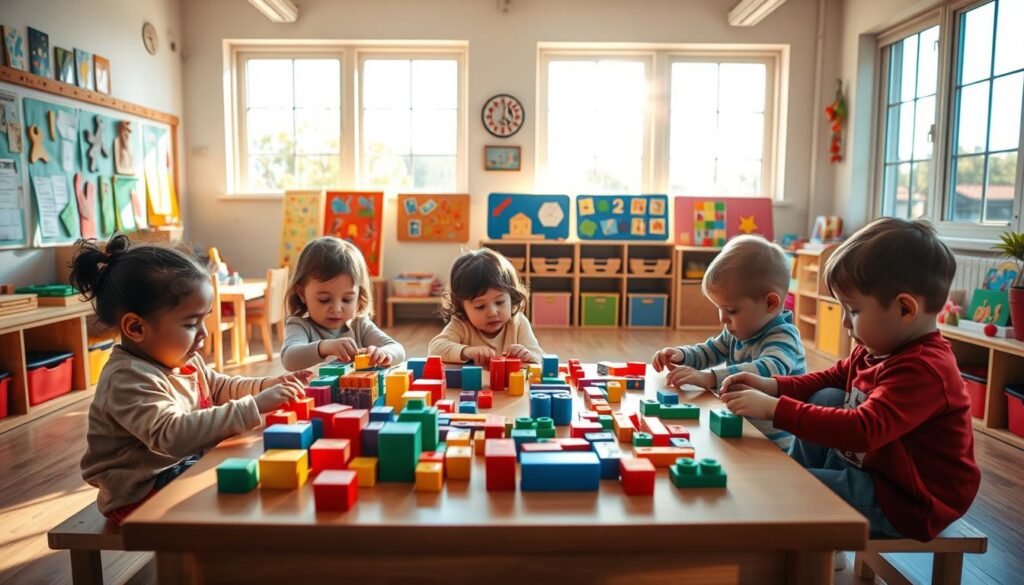
Bilingual Curriculum and Academic Excellence
The bilingual program at Raffles Kidz International is designed to enhance language proficiency in both English and Mandarin. Through thematic science and art modules, children engage in exploratory activities that make learning fun and meaningful.
Teachers use tactile number recognition systems to help children grasp mathematical concepts. This approach ensures that academic skills are built on a strong foundation of understanding and curiosity.
Hands-On Learning and Exploratory Activities
At Raffles Kidz International, hands-on learning is at the heart of the curriculum. The Mini Chef nutrition program teaches children about healthy eating through practical cooking sessions. Community cultural projects encourage them to explore diverse traditions and values.
Nature journaling exercises allow children to connect with the environment while developing observational and writing skills. These activities foster creativity and a love for learning in a supportive setting.
- Tactile number recognition systems for math skills
- Mini Chef program for nutrition education
- Community cultural projects for global awareness
- Nature journaling for environmental connection
- Full waitlist management strategies for smooth enrollment
For more insights into top-rated institutions, check out this comprehensive guide. Raffles Kidz International continues to set a high standard for early education, making it a trusted choice for parents.
The Schoolhouse by Busy Bees: Inspiring Future Challengers
The Schoolhouse by Busy Bees is dedicated to fostering curiosity and resilience in young learners. With a focus on holistic development, this institution provides a nurturing environment where children can explore, innovate, and grow. Its programs are designed to prepare children for future challenges through a blend of creativity and structure.
Bilingual Immersion Core Curriculum
The Schoolhouse offers a bilingual immersion program that enhances language proficiency in both English and Mandarin. Daily bilingual classes ensure children develop strong communication skills. This approach not only builds linguistic abilities but also fosters cultural awareness and global understanding.
Experiential Learning and Enrichment Programs
At The Schoolhouse, experiential learning is a cornerstone of the curriculum. Children engage in activities like robotics, coding, and taekwondo, which promote critical thinking and physical development. These hands-on experiences make learning engaging and meaningful.
The institution also offers a variety of enrichment programs to cater to diverse interests. Highlights include:
- Water/Sand Play certification for outdoor exploration.
- Mini-Olympics physical program to encourage teamwork and fitness.
- Entrepreneurship market days where children learn business basics.
- Inter-campus competitions to foster healthy rivalry and collaboration.
- Four infant care centers with sleep training for the youngest learners.
For more details about The Schoolhouse’s innovative programs, visit their official page. This institution continues to inspire young minds, making it a trusted choice for parents seeking a well-rounded education for their children.
Brighton Montessori: Individualized Learning Experience
Brighton Montessori offers a unique approach to early education, focusing on individualized learning. This institution is dedicated to nurturing each child’s potential through a Montessori philosophy that emphasizes hands-on exploration and self-directed growth. By tailoring lessons to meet individual needs, children develop confidence and a love for learning.
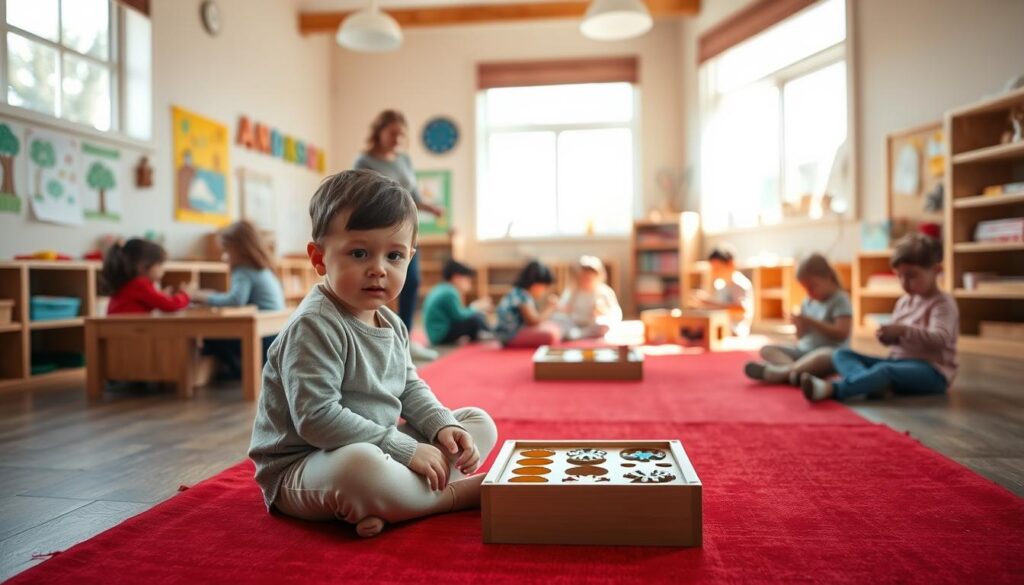
Montessori Philosophy and Hands-On Approach
At Brighton Montessori, the curriculum is rooted in the Montessori method. Children engage in hands-on activities that encourage curiosity and independence. From sensory play to practical life skills, every activity is designed to foster cognitive and social development.
Teachers hold Montessori diplomas, ensuring they are well-equipped to guide young learners. The 1:6 teacher-to-child ratio for nursery groups allows for personalized attention, helping each child progress at their own pace.
Expert Educators and Strong Parent Partnerships
Brighton Montessori values collaboration between educators and families. Bi-weekly parent skill workshops provide tools to support learning at home. These sessions strengthen parent partnerships, creating a cohesive learning environment for children.
Child portfolio documentation tracks daily progress, offering insights into each child’s development. Grandparent engagement days further enrich the experience, fostering intergenerational connections and community involvement.
- Montessori diploma requirement for educators.
- Bi-weekly parent skill workshops for family involvement.
- Child portfolio documentation to track progress.
- Grandparent engagement days for community building.
- 1:6 teacher-to-child ratio for personalized attention.
Brighton Montessori’s commitment to individualized learning ensures every child receives the support they need to thrive. With expert educators and strong family partnerships, this institution stands out as a leader in early education.
Little Green House: Excellence in Child and Infant Care
Little Green House has established itself as a leader in early childhood education. Known for its innovative programs and nurturing environment, it provides a strong foundation for young learners. The institution focuses on holistic development, ensuring children thrive academically and socially.
Award-Winning Literacy SMART™ Programme
The Literacy SMART™ Programme is a standout feature at Little Green House. This award-winning initiative enhances language skills through interactive activities. Children engage with interactive word walls and audio recording booths, making learning fun and effective.
Quarterly writing anthologies showcase children’s progress, while the family reading passport system encourages parent involvement. These efforts create a collaborative learning environment that supports each child’s growth.
Signature Learning Zones and Parent Involvement
Little Green House’s learning zones are designed to inspire curiosity and creativity. The Language Lab and Sound Factory areas offer hands-on experiences that make learning engaging. These spaces are tailored to foster exploration and self-directed learning.
Parents play a key role in their child’s education journey. Regular workshops and events ensure families are actively involved. With 11 centers equipped with nursing rooms, Little Green House prioritizes convenience and care for both children and parents.
| Feature | Benefit |
|---|---|
| Interactive Word Walls | Enhances vocabulary and language skills |
| Audio Recording Booths | Improves communication and confidence |
| Family Reading Passport | Encourages parent-child bonding |
| Quarterly Writing Anthologies | Showcases progress and creativity |
| 11 Centers with Nursing Rooms | Provides convenience for families |
My First Skool: Building Confident and Curious Learners
My First Skool focuses on creating a foundation for lifelong learning in young children. With a curriculum designed to foster curiosity and confidence, this institution ensures that every child is prepared for future challenges. The emphasis on experiential learning and social skills development sets it apart as a leader in early education.
Experiential Curriculum and Social Skills Development
The curriculum at My First Skool is built around hands-on activities that encourage exploration and creativity. Children engage in projects that promote critical thinking and problem-solving. These experiences help them develop essential social skills, such as teamwork and communication.
One unique feature is the use of sensory modulation rooms. These spaces are designed to help children regulate their emotions and focus on learning. By providing a supportive environment, My First Skool ensures that every child feels safe and valued.
Qualified Educators and Nurturing Environment
My First Skool prides itself on its team of qualified educators. All staff members are ECDA-certified and undergo ongoing professional development. This commitment to excellence ensures that children receive the highest quality of care and education.
The institution also offers trauma-informed care training for its educators. This approach helps them understand and support children who may have experienced challenging situations. Additionally, allergy-aware meal plans ensure that every child’s dietary needs are met.
Here are some key features of My First Skool:
- ECDA-certified staff requirements for quality assurance.
- Trauma-informed care training to support emotional well-being.
- Sensory modulation rooms for emotional regulation.
- Allergy-aware meal plans for inclusive care.
- MOE partnership benefits for enhanced resources.
| Feature | Benefit |
|---|---|
| ECDA-Certified Staff | Ensures high teaching standards |
| Trauma-Informed Care | Supports emotional well-being |
| Sensory Modulation Rooms | Helps children focus and regulate emotions |
| Allergy-Aware Meal Plans | Caters to diverse dietary needs |
| MOE Partnership | Provides access to additional resources |
My First Skool’s commitment to a nurturing environment and experiential learning makes it a trusted choice for parents. By focusing on both academic and social development, it prepares children for a bright future.
Little Skool-House: Preparing Children for Primary School
Transitioning to primary school is a significant milestone for young learners. Little Skool-House focuses on equipping children with the skills and confidence they need to thrive in this new environment. Their programs emphasize bilingual proficiency, critical thinking, and a relationships-based approach to learning.
Bilingual Proficiency and Critical Thinking Skills
At Little Skool-House, children develop strong bilingual skills in English and Mandarin. Language learning is integrated into daily activities, ensuring fluency and confidence. The curriculum also fosters critical thinking through problem-solving tasks and interactive projects.
One standout initiative is the canteen simulation program. Children practice decision-making, budgeting, and social interactions in a realistic setting. This hands-on experience prepares them for real-world scenarios they’ll encounter in primary school.
Relationships-Based Curriculum and Primary School Formation
The relationships-based curriculum at Little Skool-House focuses on building strong connections between peers, teachers, and families. This approach creates a supportive environment where children feel valued and motivated to learn.
Key initiatives include:
- A buddy system pairing younger children with older peers for guidance.
- School bag organization drills to teach responsibility and independence.
- Public transport safety workshops to prepare children for commuting.
- Time management visual schedules to help children stay organized.
- Alumni mentoring initiatives for ongoing support and inspiration.
| Initiative | Benefit |
|---|---|
| Buddy System | Encourages peer support and mentorship |
| School Bag Drills | Teaches organization and responsibility |
| Safety Workshops | Prepares children for independent commuting |
| Time Management Schedules | Helps children stay organized and focused |
| Alumni Mentoring | Provides ongoing guidance and inspiration |
Little Skool-House’s comprehensive approach ensures children are well-prepared for the challenges of primary school. By focusing on academic, social, and practical skills, they create a strong foundation for lifelong learning.
Agape Little Uni.: Affordable Quality Preschool Education
Agape Little Uni. combines affordability with high-quality education for young learners. With a capacity of over 1,000 students, this institution ensures every child receives personalized attention while fostering a love for learning. Its programs are designed to nurture curiosity, creativity, and character.
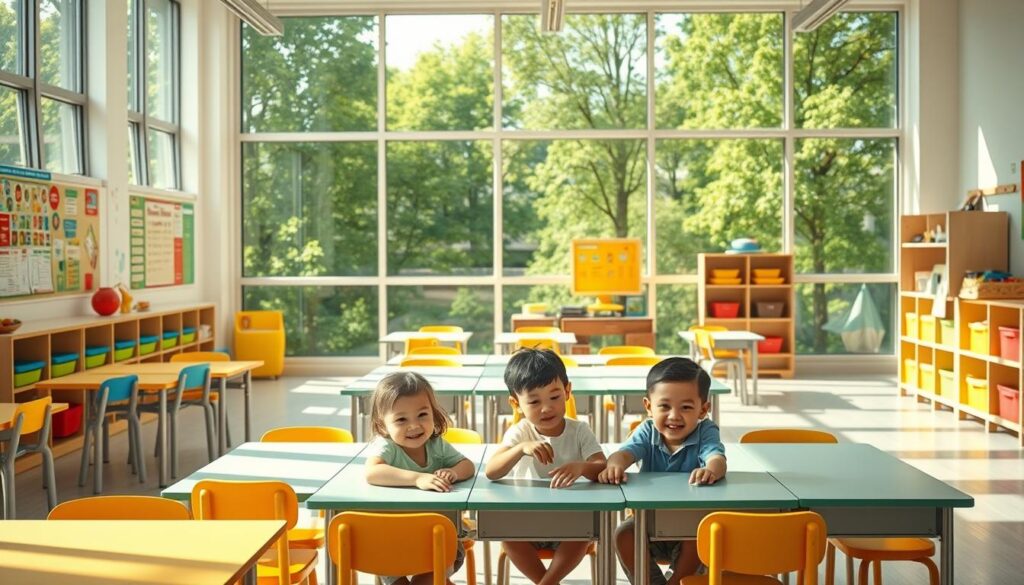
Inquiry-Based Learning and Character Development
At Agape Little Uni., children engage in inquiry-based learning that encourages them to ask questions and explore solutions. This approach helps develop critical thinking and problem-solving skills. Character development is also a priority, with activities that teach values like respect, responsibility, and teamwork.
Conducive Environment and Parental Involvement
The school’s conducive environment is designed to inspire learning and creativity. Bright, interactive classrooms and co-designed learning corners make every space engaging. Parents play an active role through talent-sharing sessions and the family wall of fame, which celebrates their contributions to the school community.
Here are some standout features of Agape Little Uni.:
- Family wall of fame to recognize parent contributions.
- Parent talent sharing sessions for community engagement.
- Co-designed learning corners to inspire creativity.
- Affordable fee structure for accessible education.
- Multiple pickup and dropoff windows for convenience.
Key Factors to Consider When Choosing a Preschool
Selecting the right learning environment for your child involves careful consideration of several factors. Parents must balance practical needs with educational quality to ensure the best fit for their family. Here are some key aspects to evaluate when making this important decision.
One of the first considerations is the proximity vs. quality balance. While a nearby location is convenient, it’s essential to prioritize the institution’s educational standards. Visiting multiple options can help you assess whether the travel time is worth the benefits.
Accreditation is another critical factor. Cross-checking certifications like SPARK ensures the school meets high standards in teaching quality, safety, and curriculum design. This step provides peace of mind that your child is in a reputable environment.
Reviewing emergency protocols is equally important. Schools should have clear procedures for handling accidents, illnesses, or other unexpected situations. This ensures your child’s safety and well-being are prioritized.
Cultural or religious alignment can also play a role in your decision. Many families prefer institutions that reflect their values and traditions. This alignment creates a consistent learning experience between home and school.
Finally, consider the school’s sibling policy. Some institutions offer discounts or priority enrollment for siblings, making it easier to manage logistics for families with multiple children.
| Factor | Importance |
|---|---|
| Proximity vs. Quality | Balances convenience with educational standards |
| Accreditation | Ensures high teaching and safety standards |
| Emergency Protocols | Prioritizes child safety and well-being |
| Cultural/Religious Alignment | Creates consistency between home and school |
| Sibling Policy | Simplifies logistics for families with multiple children |
By evaluating these factors, parents can make an informed choice that supports their child’s early childhood development. The right institution provides a nurturing environment where young learners can thrive.
Curriculum and Teaching Style: Finding the Right Fit
Understanding the right curriculum style and teaching approach is essential for your child’s growth. Schools often fall on a spectrum between progressive and traditional methods. Progressive programs focus on hands-on learning and creativity, while traditional methods emphasize structured lessons and academic rigor.
Technology integration is another key factor. Some schools incorporate tablets and interactive tools to enhance learning, while others prioritize face-to-face interactions. The level of tech integration can influence how children engage with the material and develop digital literacy.
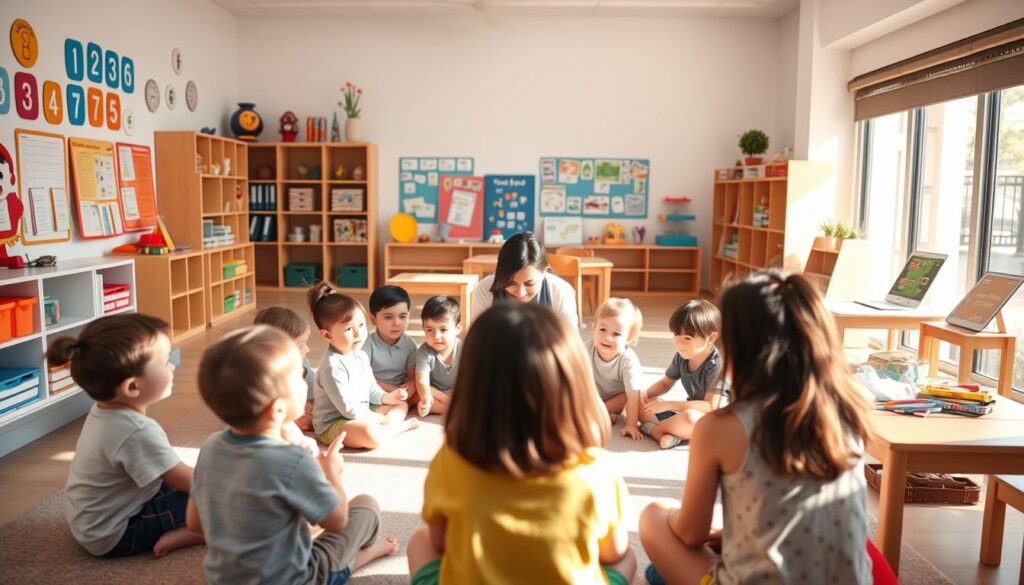
Assessment methodology varies widely. Some institutions use continuous evaluation through projects and observations, while others rely on periodic tests. Understanding how a school measures progress can help you align with your child’s learning needs.
Special needs support is crucial for inclusive education. Schools with trained staff and tailored programs ensure every child receives the attention they deserve. Look for institutions that prioritize individualized learning plans and accessible resources.
Finally, co-curricular balance plays a significant role. A well-rounded program includes arts, sports, and other activities that complement academic learning. This balance fosters holistic development and keeps children engaged.
| Factor | Details |
|---|---|
| Progressive vs. Traditional | Hands-on learning vs. structured lessons |
| Tech Integration | Use of digital tools to enhance learning |
| Assessment Methodology | Continuous evaluation or periodic tests |
| Special Needs Support | Individualized learning plans and resources |
| Co-Curricular Balance | Arts, sports, and activities for holistic growth |
Class Size and Teacher-to-Child Ratio: Ensuring Personalized Attention
The right class size and teacher-to-child ratio can make a big difference in early education. These factors directly impact how much individual attention each child receives, which is crucial for their development. Smaller groups allow teachers to focus on each child’s unique needs, fostering a supportive learning environment.
According to ECDA guidelines, the maximum teacher-to-child ratio varies by age group. For example, infant care centers maintain a 1:5 ratio, while kindergartens may have a 1:25 ratio. These standards ensure that children receive adequate supervision and care. Many schools also employ assistant teachers to further support classroom management.
Activities are often designed to balance group and individual learning. Group tasks encourage teamwork and social skills, while individual activities allow children to explore at their own pace. During transition periods, such as starting school or moving to a new class, smaller ratios help children adjust more smoothly.
Parents are encouraged to attend observation days to see how class sizes and teacher interactions work in practice. This firsthand experience can provide valuable insights into whether the environment meets their child’s needs. As one educator noted,
“A low teacher-to-child ratio ensures that no child is left behind.”
| Age Group | Maximum Teacher-to-Child Ratio |
|---|---|
| Infant Care | 1:5 |
| Playgroup | 1:8 |
| Kindergarten | 1:25 |
Choosing a school with an ideal teacher-to-child ratio ensures your child receives the attention they need to thrive. Whether it’s through group activities or individual support, this balance plays a vital role in their early learning journey.
School Environment and Facilities: Creating a Safe Learning Space
A well-designed school environment plays a crucial role in fostering a child’s growth and development. From outdoor play areas to indoor learning zones, every detail contributes to a safe learning experience.
Outdoor play spaces are essential for physical activity and exploration. These areas should meet safety standards, with soft surfaces and secure fencing. Regular inspections ensure they remain hazard-free for young learners.
Indoor facilities are equally important. Air purification systems maintain clean air quality, reducing the risk of illnesses. Childproofing audits help identify and address potential hazards, creating a secure environment for children to explore.
Learning zones are segmented to cater to different activities. Quiet corners encourage focused tasks, while interactive areas promote group play. This segmentation helps children transition smoothly between activities.
Natural lighting assessments ensure classrooms are bright and inviting. Studies show that well-lit spaces enhance concentration and mood, supporting a positive learning atmosphere.
- Outdoor play spaces with safety features.
- Air purification systems for clean indoor air.
- Childproofing audits to eliminate hazards.
- Segmented learning zones for varied activities.
- Natural lighting to boost focus and well-being.
By prioritizing these elements, schools create a nurturing and safe learning environment where children can thrive. Parents can feel confident knowing their child is in a space designed for their growth and safety.
Bilingual Programs: Enhancing Language Skills
Bilingual programs are a cornerstone of early childhood education, offering children a unique advantage in language acquisition. These programs are designed to develop fluency in two languages, fostering cognitive and social benefits that last a lifetime.
One key aspect of bilingual education is the choice between immersion vs. translation methods. Immersion programs teach subjects entirely in the second language, while translation methods use both languages interchangeably. Immersion is often more effective for achieving fluency, as it mimics natural language learning.
Native speaker qualifications are another critical factor. Teachers who are native speakers bring authenticity and cultural depth to the classroom. Their expertise ensures accurate pronunciation and idiomatic usage, which are essential for mastering a language.
Home language reinforcement plays a vital role in supporting bilingual education. Parents can encourage language practice through reading, conversations, and cultural activities. This consistency between school and home accelerates learning and builds confidence.
Proficiency benchmarking helps track a child’s progress. Regular assessments measure skills in speaking, reading, and writing, ensuring that learning goals are met. These benchmarks provide valuable feedback for both educators and parents.
Cultural context integration enriches the learning experience. Bilingual programs often include cultural festivals, storytelling, and traditions from the target language’s culture. This approach fosters a deeper understanding and appreciation of diverse backgrounds.
| Element | Benefit |
|---|---|
| Immersion Method | Promotes fluency through natural learning |
| Native Speaker Teachers | Ensures accurate language use |
| Home Language Reinforcement | Supports consistent practice |
| Proficiency Benchmarking | Tracks progress and sets goals |
| Cultural Context Integration | Enhances cultural understanding |
By focusing on these elements, bilingual programs provide a comprehensive approach to developing language skills. They prepare children for a multilingual world, equipping them with tools for success in both academic and social settings.
Budget and Hidden Costs: Planning for Preschool Expenses
Planning for early education involves more than just tuition fees; understanding the full scope of costs is essential. Many parents are surprised by additional expenses like uniforms, materials, and enrichment programs. Being aware of these hidden costs helps families budget effectively and avoid financial stress.
One of the first steps is checking government subsidy eligibility. Many institutions offer financial aid based on income levels, making quality education more accessible. These subsidies can significantly reduce tuition fees, easing the financial burden on families.
Sibling discount policies are another way to save. Schools often provide reduced fees for families enrolling multiple children. This benefit can make a big difference for parents managing preschool expenses for more than one child.
Enrichment class add-ons are common but can add up quickly. Activities like music, art, or sports may require extra fees. While these programs enhance learning, it’s important to factor them into your budget from the start.
Deposit refund conditions vary by institution. Some schools refund deposits upon graduation, while others deduct fees for damages or unpaid bills. Understanding these terms ensures there are no surprises later.
Insurance coverage is another consideration. Many schools include accident or health insurance in their fees, but it’s wise to verify the details. This ensures your child is protected in case of emergencies.
“A well-planned budget ensures that every child has access to quality education without compromising family finances.”
- Check government subsidy eligibility to reduce tuition fees.
- Inquire about sibling discount policies for multiple enrollments.
- Factor in enrichment class add-ons when planning your budget.
- Understand deposit refund conditions to avoid unexpected costs.
- Verify insurance coverage details for your child’s safety.
By considering these factors, parents can create a realistic budget and ensure their child’s early education journey is both enriching and affordable.
Conclusion: Making the Best Choice for Your Child
Choosing the right learning environment for your child is a deeply personal decision that requires careful thought and consideration. Trusting your parental intuition is key, as you know your child’s needs and personality best. Gradual transition strategies, such as trial sessions, can help ease your child into their new routine and build confidence.
Ongoing communication with educators ensures you stay informed about your child’s progress. Regular updates and parent-teacher meetings provide valuable insights into their development. Monitoring progress through observations and feedback helps you gauge whether the environment is the right fit.
If challenges arise, don’t hesitate to reconsider your choice. Flexibility is important in finding a place where your child can thrive. Remember, early childhood education is about nurturing curiosity and building a strong foundation for lifelong learning.
By focusing on these strategies, you can make an informed decision that supports your child’s growth and happiness. Whether it’s the best preschool Singapore or another option, the right choice will set them on a path to success.

